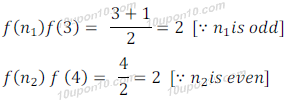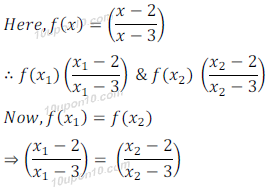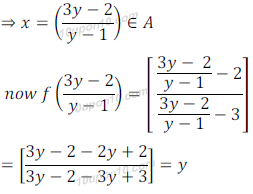Relations and Functions NCERT Solutions
NCERT Exercise 1.2 Q: 6 - 12
Question: 6. Let A = {1, 2, 3,}, B = {4, 5, 6, 7 } and let f = {(1, 4), (2, 5), (3, 6)} be a function from A to B. Show that f is one-one.
Solution:
Here, A = {1, 2, 3} and B = {4, 5, 6, 7}
F: A →B = {(1, 4), (2, 5), (2, 6)}
F (1) = 4, f(2) = 5 and f(3) = 6
⇒ f(x1) ≠ f(x2) for every x1 ≠ x2
So, f is one-one function.
Question: 7. In each of the following cases state whether the function is one-one, onto or bijective. Justify your answer.
(i) f :R → R define by f(x) = 3 – 4x
(ii) f : R → R defined by f(x) = 1 + x2
Solution:
(i) Let x1 and x2 ∈ R
Here f(x) = 3 – 4x
Then f(x1) = 3 – 4x1
and f (x2) = 3 – 4x2
Now f(x1) = f (x2)
⇒ 3 – 4x1 = 3 – 4x2
⇒ – 4x1 = –4x2
⇒ x1 = x2
∴ f(x1) = f(x2)
& x1 = x2
So, f is one-one function.
Let f(x) = y ∈ R

So, f is onto function.
(ii) Let x1 = 2 and x2 = –2 ∈ R
Here f(x) = 1 + x2
Then f(x1) = f (2) = 1 + (2) 2 = 5
and f (x2) = f(–2) = 1 + (–2) 2 = 5
∴ f (x1) = f(x2) but x1 ≠ x2
So, f is not one-one function.
Let f(x) = – 2 ⇒R
Then 1 + x2 = –2
⇒ x2 = –3 = ± √–3 ∈R
So, f is not onto function.
Question: 8. Let A and B sets show that f : A x B → B x A such that f (a, b) = (b, a) is bijective function.
Solution:
Let x1 = (a, b) and x2 = (c, d) ∈ A x B
Then f (x1) = f (a, b) = (b, a)
F(x2) = f (c, d) = (d, c)
Now f (x1) = f (x2)
⇒ (b, a) = (d, c) ⇒b = d and a = c
Now x1 = (a, b) = (c, d) = x2
& there4; f(x1) = f(x2)⇒ x1 = x2
So f is one-one function.
Let y = (p, q) ∈ B x A and x = (a, b) ∈ A x B
∴ f(a, b) = (p, q)
⇒ (b, a) = (p, q)⇒ b = p and a = q
&rArr x = (a, b) = (p, q)
Also f (x) = f (q, p) = (p, q) = y
So, f is onto function.
Thus f is one-one and onto function.
Question: 9. Let f: N → N be defined by f(n)  for all n ∈ N. State whether the function f is bijective. Justify your answer.
for all n ∈ N. State whether the function f is bijective. Justify your answer.
Solution:
Let n1 = 3 and n2 – 4 ∈ N

∴ f(n1) = f (n2) but n1 ≠ n2
So, f is not one-one function.
Since, f is not one - one, it can't be bijective.
Question: 10. Let A = R – {3} and B = R – {1}. Consider the function f : A → B defined by  . Is f one-one and onto? Justify your answer.
. Is f one-one and onto? Justify your answer.
Solution:
Let x1 ≠ 3 and x2≠ 3 ∈ A

⇒ (x1 – 2)(x2 –3) = ((x1 – 3) ((x2 – 2)
⇒ x1 x2 – 3x1 – 2x2 + 6 = x1x2 – 2x1 – 3x2 + 6
⇒ – 3x1 – 2x2 = –2x1 – 3x2
⇒ –3x1 + 2x1 = –3 x2 + 2x2
⇒ – x1 = –x2
⇒ x1 = x2
∴ f(x1) = f (x2)
⇒ (x1) = (x2)So, f is one-one function.
Let f(x) = y ≠ 1 ∈ B
⇒ x – 2 = y (x – 3)
⇒ x – 2 = xy – 3y
⇒ x(y – 1) = 3y – 2

Since x is the only value for which f(x) = y (as proved avove), f is onto function. Thus, f is one-one and onto function.
Question: 11. Let f : R → R be defined as f(x) = x4 choose the correct answer.
(A) f is one -one onto
(B) f is many -one onto
(C) f is one -one but not onto
(D)f is neither one -one nor onto
Solution:
Let x1 = 2 and x2 = 2 ∈ R
Here, f(x) = x4
Then, f(x1) = f(2) = 24 = 16
and f(x2) = f(–2)= (–2)4 = 16
∴ f(x1) = f(x2) but x1 ≠ x2
So, f is not one-one function.
Let f(x) = – 2 ∈ R
Then x4 = –2 which is not possible because there is no value of x corresponding to which x4 = –2
So, f is not onto function.
Thus, f is neither one-one nor onto.
So, answer is (D).
Question: 12. Let f : R → R be defined as f(x) = 3x choose the correct answer.
(A) f is one-one onto
(B) f is many-one onto
(C) f is one -one but onto
(D) f is neither one-one nor onto.
Solution:
Let, x1 and x2 ∈ R
Here, f(x) = 3x
Then, f (x1) = 3x1 and f(x2) = 3x2
Now f(x1) = f(x2)
⇒ 3 x1 = 3 x2
⇒ x1 = x2
∴ f(x1) = f(x2) implies x1 = x2
So, f is one-one function.
Let f(x) = y ∈ R. Then, 3x = y

So, f is onto function.
Thus f is one-one and onto function. So answer is (A).
Reference: